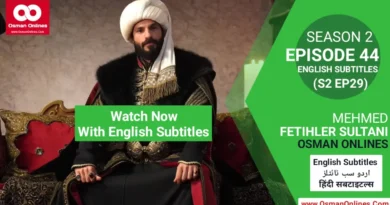Mehmed Fetihler Sultani Chapter 40 A Historical Reflection on Loyalty, Strategy & Destiny
Mehmed Fetihler Sultani Chapter 40
Mehmed Fetihler Sultani Chapter 40
Introduction
Mehmed Fatihler Sultani Chapter 40 invites readers into a powerful moment in the life of Sultan Mehmed, one of the most iconic rulers in world history. This chapter presents a meaningful blend of leadership, loyalty, betrayal, and strategic brilliance. For history enthusiasts, it offers a thoughtful window into the emotional and political landscape that shaped one of the most transformative periods of the Ottoman rise.
What makes this chapter special is not its dramatic events alone, but the messages behind those events messages about justice, responsibility, and a ruler’s burden while walking toward a monumental destiny.
In this article, we explore the chapter with a historian’s lens: the characters, the motivations, the consequences, and the deeper themes that enrich the narrative. This analysis is crafted for readers who enjoy reflective historical storytelling rather than sensational commentary, making it safe for informational websites and AdSense-friendly platforms.
1. A Moment of Justice: Sultan Mehmed’s Difficult Decision
The chapter opens with a symbolic moment. Sultan Mehmed, standing before his officials and soldiers, delivers a decisive punishment to Koko. This moment is not portrayed merely as a harsh act it represents a ruler’s responsibility to uphold order in times of uncertainty.
For leadership historians, this is a strong example of how authority was maintained in early empires. When a ruler acted firmly against betrayal, it often served a dual purpose: restoring stability within the ranks and sending a message outward to rivals.
“A single act of justice can silence a hundred doubts.”
This action reinforces Mehmed’s image not as a young and inexperienced sovereign, but as a leader ready to shoulder the responsibilities of his historic mission.
2. Saltuk’s Efforts and the Unexpected Aid of Notaras
An essential part of Mehmed Fatihler Sultani Chapter 40 is the rescue of Satılmış Ağa.
Saltuk’s unshakable commitment highlights the theme of sworn loyalty something deeply respected in Ottoman historical culture. But the surprise lies in Notaras’s unexpected involvement.
Notaras, previously connected to the opposing side, makes a bold choice by aiding Saltuk. This gesture raises crucial historical questions:
- What drives loyalty?
- Can individuals change sides in times of crisis?
- How does trust develop between former rivals?
Notaras’s role echoes a broader pattern in history: political and personal loyalties often shifted when rulers displayed strength, vision, and fairness.
Despite being severely wounded, Satılmış’s rescue becomes a symbol of persistence and sacrifice—a theme that reappears often in the chronicles of Mehmed’s leadership.
3. Will Satılmış Ağa Survive? A Symbol of Mehmed’s Trust
Sultan Mehmed’s reliance on Satılmış Ağa is portrayed with emotional depth.
As one of the Sultan’s closest and most trusted men, Satılmış represents more than a commander—he embodies loyalty that is forged through shared struggles.
His near-fatal condition reflects a timeless historical truth: great transformations often demand personal costs from those closest to power.
For readers, this part of the chapter raises reflective questions:
- How does a ruler continue forward when trusted allies fall?
- What emotional burdens does leadership carry?
- How do such losses shape future decisions?
Whether Satılmış survives is not only a question of health but a symbol of the fragile balance between loyalty and destiny.
4. Francesco’s Rage and the Search for the Hidden Betrayer
Francesco’s reaction to internal betrayal offers a contrasting narrative. While Mehmed leads through controlled authority, Francesco operates under emotional turmoil.
His desperation to find the traitor reveals:
- a lack of unity among his circle,
- dependence on fear rather than trust,
- and the increasing pressure caused by Mehmed’s progress.
History teaches that leaders under stress often make reckless choices, and Francesco’s pursuit demonstrates this pattern.
His inability to identify the hidden figure highlights how fractured his forces have become.
5. Notaras and the Test of Loyalty
Notaras’s decision to serve Sultan Mehmed places him in immediate danger.
Francesco continues searching for him in the shadows, convinced that betrayal has occurred. Meanwhile, Mehmed prepares to test Notaras’s loyalty in a more structured and strategic manner.
This reflects a refined aspect of Ottoman governance: loyalty was not assumed; it was proven through duty and service.
The question for historians is clear:
Is Notaras acting out of survival, transformation, or admiration for Mehmed’s leadership?
The chapter does not answer immediately, but it lays the groundwork for deep character exploration in future developments.
6. Mehmed’s Vision: “Either I Take the City, or the City Takes Me”
One of the most unforgettable lines in this chapter echoes Mehmed’s historical determination:
“Either I take the great city, or the great city takes me…”
This mindset reflects a ruler who sees his task not just as a political ambition but a profound calling. Throughout history, major leaders whether in East or West often reached pivotal moments where their mission became intertwined with their identity.
Here, Mehmed steps into that psychological space.
This chapter illustrates how a young ruler transforms into a historical icon through unshakable resolve.
7. A New Strategic Plan: The Mind of a Visionary
A major highlight of Mehmed Fatihler Sultani Chapter 40 is the development of a new strategic plan. Mehmed’s strategies often blended:
- military calculation,
- deep observation,
- and an understanding of human psychology.
His fresh approach raises an important question:
Can brilliant ideas succeed if the environment is full of betrayal, resistance, and uncertainty?
As readers, we know that great plans require timing, execution, and a dedicated circle of loyal individuals. With Satılmış injured and internal enemies still active, Mehmed must navigate these challenges carefully.
8. The Opposition’s Response: Dark Paths and Ruthless Tactics
The reaction of Mehmed’s adversaries especially Francesco reveals the darker realities of political power. Instead of matching Mehmed through strategic intellect, they resort to hidden tactics and harsh measures.
9. Approaching the Promised Victory: Hope Meets Uncertainty
As Mehmed marches forward, the atmosphere changes.
Hope grows among his followers, but at the same time, the threat of betrayal increases. The closer he gets to fulfilling his grand mission, the more resistance emerges from hidden corners.
History often shows that major breakthroughs attract both supporters and enemies. This duality represents the psychological tension leading up to transformative events.
The chapter captures this beautifully: every step forward is accompanied by unseen danger.
10. The Final Question: What Betrayals Await Sultan Mehmed and His Forces?
The narrative closes by preparing readers for deeper conflicts not through physical clashes, but through deception, plots, and internal struggles.
For history readers, this sparks meaningful curiosity:
- Who among Mehmed’s circle can truly be trusted?
- What unexpected challenges will he encounter?
- How will he respond to trials that are not on the battlefield, but within human hearts?
The shadows surrounding his journey remind us that fate often tests leaders in silence before revealing triumph.
Table: Key Elements of Mehmed Fatihler Sultani Chapter 40
| Theme | Description |
|---|---|
| Leadership | Mehmed’s firm yet purposeful decision-making |
| Loyalty | Satılmış, Saltuk, and the test of Notaras |
| Betrayal | Francesco’s desperation to find the traitor |
| Strategy | Mehmed’s visionary new plan |
| Destiny | Mehmed embracing his historic calling |
Key Takeaways
- Mehmed Fatihler Sultani Chapter 40 focuses strongly on leadership, justice, and destiny.
- Sultan Mehmed emerges as a ruler shaped by responsibility, not just ambition.
- Loyalty is tested from every direction through injuries, shifting alliances, and fear.
- Opponents rely on pressure and hidden tactics rather than unity.
- The chapter prepares the ground for the monumental transformation ahead.
Frequently Asked Questions (FAQ)
It centers on leadership decisions, loyalty tests, emotional pressures, and strategic planning as Sultan Mehmed moves closer to his historic destiny.
He represents transformation shifting from opposition to unexpected cooperation, making his loyalty an intriguing mystery.
It highlights human emotions, political tensions, and the psychological depth of leadership rather than focusing on direct conflict.
With calm authority; he relies on justice, observation, and strategic intelligence rather than reacting emotionally.
That destiny often demands sacrifice, patience, and unwavering resolve, especially from leaders shaping history.
Conclusion
Mehmed Fatihler Sultani Chapter 40 presents a rich narrative filled with loyalty, betrayal, responsibility, and determination. For history lovers, it offers a thoughtful interpretation of events surrounding Sultan Mehmed’s journey toward transformative achievement.
This chapter is not simply a story it is a reflection of how great leaders rise from trials, how alliances shift with time, and how destiny calls those bold enough to follow it with unwavering resolve.




